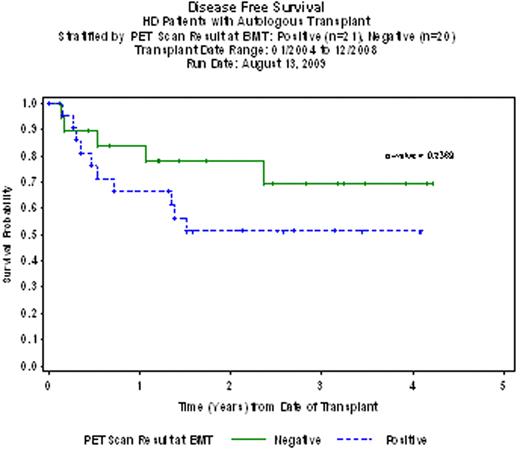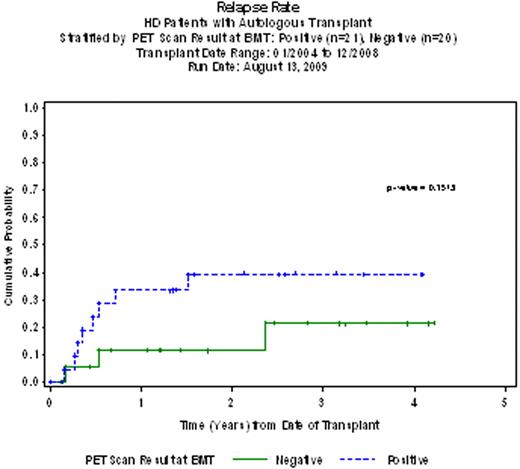Abstract
Abstract 1225
Poster Board I-247
High dose chemotherapy and AHCT can effectively salvage 50-60% of relapsed HL patients with chemosensitive disease and about 25-40% of patients with chemorefractory disease. Patients with chemosensitive disease at time of AHCT will have improved progression free survival and decreased relapse rate. Traditionally, standard response criteria use conventional computed tomography (CT) scans as the radiographic assessment tool. However, CT scans often can not distinguish between residual disease and scar tissue in malignant lymphomas status post chemotherapy. Functional imaging with FDG-PET is more sensitive and specific than CT scans for characterization of residual mass after chemotherapy, and may offer more prognostic information. The predictive value of FDG-PET on clinical outcomes among HL patients who undergo AHCT has been reported by relatively few centers. We conducted a retrospective analysis of 41 consecutive HL patients who had FDG-PET scan after at least two cycles of salvage chemotherapy and before undergoing AHCT at City of Hope National Medical Center.
To determine the prognostic impact of pre-transplant functional FDG-PET in predicting the outcome of AHCT in relapsed HL.
A total of 41 consecutive HL patients who had FDG-PET scan after at least two cycles of salvage chemotherapy and before undergoing AHCT at City of Hope National Medical Center between January 2004 and December 2008 were included in this analysis.
Patient characteristics show median age is 36. 34 patients were chemosensitive at time of AHCT. 31 patients received BCNU/VP-16/CTX, 9 patients received BCNU/VP-16/MEL/Ara-C, and 1 patient received fTBI/VP-16/CTX. Median number of prior regimen is 2. 11 patients received radiation at induction. The patients were then categorized into FDG-PET positive (N=21) and negative (N=20) groups. The median follow-up for all patients after AHCT was 24.1 months (1.3, 54.2). The disease free survival (DFS) at 2 years for FDG-PET positive group was 51.3% (CI 39.7% - 61.8%) compared to 77.9% (CI 58.3% - 89.0%) for the FDG-PET negative (p=0.24). The 2-years overall survival (OS) for FDG-PET positive was 73.9% (CI 55.8% - 85.4%) versus 83.5% (CI 62.7% - 93.3%) for FDG-PET negative (p=0.63). There was a trend for lower relapse rate in the FDG-PET negative patients. The probability of relapse at 1 year for FDG-PET positive was 33.3% (CI 21.9% - 48.7%) compared to 11.5% (CI 3.5% - 34.0%) for FDG-PET negative (p= 0.15). There was no significant difference between the FDG-PET positive group versus FDG-PET negative group in terms of gender, time from diagnosis to transplant, conditioning regimen, number of prior regimens, radiation at induction, KPS at AHCT, or stage at diagnosis.
Pre-transplant functional FDG-PET is useful in predicting the outcomes AHCT in relapsed HL. Our data suggests that a positive FDG-PET prior to AHCT predicts for relapses and decreased DFS.
No relevant conflicts of interest to declare.
Author notes
Asterisk with author names denotes non-ASH members.



This feature is available to Subscribers Only
Sign In or Create an Account Close Modal